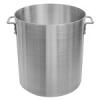Hi AltonBrownFanClub, Prop 65 is a strange issue to learn about indeed. I didn't find much better information either, but it appears the limits are determined by "Safe Harbor Levels". If the exposure level in your food (I would guess a single serving of it) exceed those set in the list linked below, you would need a warning:
https://oehha.ca.gov...s-nsrls-maximum
However, if you look on this list, Mercury is not listed. Here are the rules if your chemical is called out by Prop 65 but does not have a value listed on the Safe Harbor list:
>What are Safe Harbor numbers?
To guide businesses in determining whether a warning is necessary or whether discharges of a chemical into drinking water sources are prohibited, OEHHA has developed safe harbor levels for many Proposition 65 chemicals. A safe harbor level identifies a level of exposure to a listed chemical that does not require a Proposition 65 warning. A business does not need to provide a warning if exposure to a chemical occurs at or below these levels. These safe harbor levels consist of No Significant Risk Levels for chemicals listed as causing cancer and Maximum Allowable Dose Levels for chemicals listed as causing birth defects or other reproductive harm. OEHHA has established more than 300 safe harbor levels and continues to develop more levels for listed chemicals.
>What if there is no Safe Harbor Level?
If OEHHA has not established a safe harbor level for a chemical, businesses that expose individuals to that chemical would be required to provide a Proposition 65 warning, unless the business can show that the anticipated exposure level will not pose a significant risk of cancer or reproductive harm. OEHHA has adopted regulations that provide guidance for businesses in calculating their own level in the absence of an OEHHA safe harbor level. Regulations are available at Article 7 and Article 8 of Title 27, California Code of Regulations.
Determining anticipated levels of exposure to listed chemicals can be very complex. Although a business has the burden of proving a warning is not required, a business is discouraged from providing a warning that is not necessary and instead should consider consulting a qualified professional if it believes an exposure to a listed chemical may not require a Proposition 65 warning.
(^from: https://www.p65warni...sked-questions)
It looks like you would need to prove somehow that the exposure to mercury in your product would not pose a significant risk of cancer or reproductive harm.
Edited by Brothbro, 24 May 2023 - 09:47 PM.













